[other traps]
Drawer Trap
Drawer Trap
| Type | Explosive, drawer |
|---|
| Disarm level | 3 (easy) |
|---|
| Sensitivity | 1 (shippable) |
|---|
| Reset time | 30 seconds |
|---|
| Construction level | 3 (easy) |
|---|
| Designer | Bug |
|---|
| Date | June, 2005 |
|---|
This is an simple design for an explosive-cap trap that can be
placed in a drawer (in this case, the drawer of a box). Like most
cap traps it can be armed with just a cap or with a bit of flash
paper for a quieter but more impressive display.
This is your standard "potty-popper" explosive-cap trap built into a
drawer instead of the usual hinged-lid box. What I like about this one
(apart from the nice wood-inlay drawer-box that I picked up for $5 at a
thrift store) is the extremely simple design: aside from the popper itself
there's just one other part. The only downside is that the trap does
require placing a small hole in the back of the drawer itself.
This is what I'd call a third-level trap — it takes a little
dexterity and knowledge to disarm, but anyone with a little experience
shouldn't have any trouble getting past it. I never sent this one off to
Jay; it just sits on my shelf to surprise visitors who haven't learned to
be careful when opening boxes around my place.
Equipment
Equipment
- Drawer (either in a box or a cabinet)
- Spring-loaded popper (often sold in joke shops as "Potty Poppers" or Exploding
Toilet Seat gags).
- Caps
- Flash paper (optional). Also available at joke and magic shops.
- Short piece of spring steel, wire, or a small nail.
- Glue
Construction
Glue the popper to the left-hand wall of the drawer, about 1cm
from the back. The popper should be aligned vertically, with the cap at the
top.
Drill a small hole or slit in the back of the the drawer such that
it enters about 2cm from the bottom and 1cm from the left-hand wall. The
hole should be large enough that your wire or spring steel can fit through
easily.
Bend a short piece of wire or spring steel into an L shape,
about 4cm on a side. Glue it to the back of the box / cabinet such that
when the drawer is slid closed the wire sticks through the hole and about
2cm into the drawer (i.e. enough to block the popper). I positioned it by
putting one end through the hole (from the back of the drawer), smearing
glue on the other end and then holding it in place with some foam between
the drawer and the part to be glued as I pressed the drawer closed. After
it stuck I re-opened the drawer and pressed the wire more firmly in place
while the glue set.
| Construction |
|---|

Equipment |
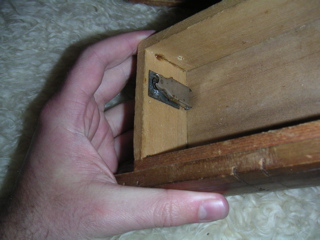
Attach to side of drawer |
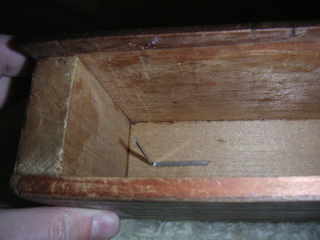
Glue spike onto back of box or cabinet. |
Arming
Arming consists of setting and loading the popper with a cap and then
closing the drawer such that the spike keeps the popper from firing. It's
the second part that can be tricky.
- Place a cap over the firing pin.
- Pull back the spring-loaded hammer that's attached halfway up the top
(non-wall-side) part of the popper, so that the hammer points down instead
of up.
- Bring the top part of the popper to the wall, thus sandwiching the
hammer and keeping it from releasing.
- Now for the tricky part: you need to close the drawer enough for the
spike to block the popper without it going off first. The normal procedure
is essentially the same thing anyone disarming the trap would do only in
reverse. Take a thin stick (a bamboo skewers or more spring steel works
well) and hold down the popper as you carefully close the drawer. Once the
spike has protruded enough that it keeps the popper from opening you can
remove the stick and close the drawer the rest of the way.
Alternative: Assuming you're trapping a drawer in a small box
rather than in a large cabinet, you can weight down the popper with a coin
or the like, and then shake it off once the drawer is closed. If the spring
on your popper is old, you might also be able to just set the drawer on its
side and hope gravity keeps the spring from going off. If so, then you can
just carefully close the drawer and then give a quick shake to let the
popper open a small amount before it's stopped by the spike — the
extra leverage will insure the trap goes off when the drawer is next
opened.
For a more dramatic effect, you can sandwich a small sheet of flash
paper between the cap and the firing pin. The paper will be held in place
by the cap, and will be set off by the cap. The bang will be a bit more
muffled than with just the cap.
| Arming |
|---|
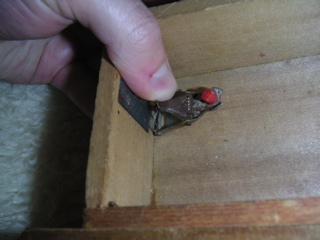
Arming |
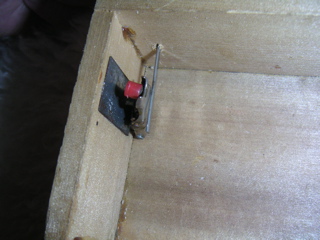
Armed |
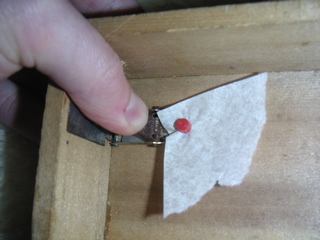
Arming with flash paper |
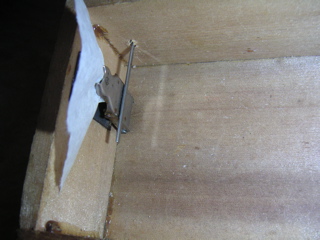
Armed with flash paper |
Firing
Once the drawer is opened enough that the spike no longer blocks the
popper, gravity and the hammer's tension will push the popper's top away
from the wall, allowing the hammer to strike the cap.
Disarming
Disarming is just the reverse of arming. Open the drawer just a tiny
bit. Then take a thin stick or wire (you do have a thin stick in
your trap-disarming kit, right?) and hold down the popper as you carefully
open the drawer. Once the drawer is opened enough to access the popper with
your fingers, cover the cap with your finger and slowly open the popper,
catching the hammer with your finger and slowly bringing it to rest
harmlessly on the cap.







